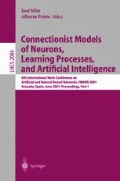Abstract
The problem of selecting a minimal number of data points required to completely specify a nonlinear separating hyperplane classifier is formulated as a concave minimization problem and solved using a linear program. A comparison of the prediction errors for several rule extraction methods shows a good compromise between complexity of the classifier and the errors.
Access this chapter
Tax calculation will be finalised at checkout
Purchases are for personal use only
Preview
Unable to display preview. Download preview PDF.
References
Andrews, R. and Geva, s. (1995). Rulex & Cebp Networks as the Basis for a rule refinement system, In: Hybrid Problems, Hybrid Solutions, j. Hallam (Ed.), pages 1–12, IOS Press
Bennet, K. P. and Mangasarian, O. L. (1992). Robust linear programming discrimination of two linearly inseparable sets. Optimization Methods and Software, 1;23–34.
Blumer, A., Ehrenfeucht, A., Haussler, D., and Warmuth, M. K. (1989). Learnability and the Vapnik-Chervonenkis dimension. Communications of the ACM, 36(4): 929–965.
Clark, P. and Niblett, T. (1989). The CN2 Induction Algorithm. Machine Learning Journal, 3(4): 261–283.
Craven, M. and Shavlik, J. (1999). Rule extraction: where do we go from here?, TR-CS-99-1, University of Wisconsin, Madison.
Mangasarian, O. L. (2000). Generalized support vector machines. In A. J. Smola, P. L. Bartlett, B. Schoelkopf, and D. Schuurmans (eds.) Advances in Large Margin classifiers, Pages 135–146, Cambridge, MA: MIT Press
Michie, D., Spiegelhalter, D. J., and Taylor, C. C. (Eds.)(1994). Machine Learning, Neural and Statistical Classification, New York: Ellis Horwood.
Nauck, D. and Kruse, R. (1995). NEFCLASS-A neuro-fuzzy approach for the classification of data, Symposium on applied computing.
Platt, J. (1998). Fast training of support vector machines using sequentil minimal optimization, In B. Schoellkopf, C. J. C. Burges, and A. J. Smola, (Eds.) Advances in Kernel Methods Support Vector Learning, Pages 185–208, Cambridge, MA: MIT Press.
Quinlan, J. R. (1986). Induction of Decision Trees. Machine Learning 1:81–106.
Valiant, L. G. (1984). A theory of the learnable. Communications of the ACM, 27:1134–42.
Vanderbei, R. J. (2001). Linear Programming: Foundations and Extensions. Kluwer.
Vapnik, V. (1995), The Nature of Statistical Learning Theory, New York: Springer-Verlag.
Wagner, T. and Wagner, O. (1995). Datenanalyse mittels Fuzzy-Clustering, diplomarbeit, TU Braunschweig.
Author information
Authors and Affiliations
Editor information
Editors and Affiliations
Rights and permissions
Copyright information
© 2001 Springer-Verlag Berlin Heidelberg
About this paper
Cite this paper
Fellenz, W.A. (2001). Reduced Support Vector Selection by Linear Programs. In: Mira, J., Prieto, A. (eds) Connectionist Models of Neurons, Learning Processes, and Artificial Intelligence. IWANN 2001. Lecture Notes in Computer Science, vol 2084. Springer, Berlin, Heidelberg. https://doi.org/10.1007/3-540-45720-8_81
Download citation
DOI: https://doi.org/10.1007/3-540-45720-8_81
Published:
Publisher Name: Springer, Berlin, Heidelberg
Print ISBN: 978-3-540-42235-8
Online ISBN: 978-3-540-45720-6
eBook Packages: Springer Book Archive

